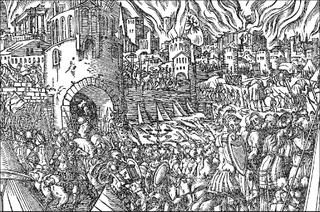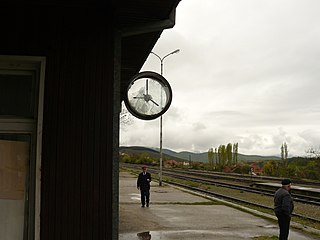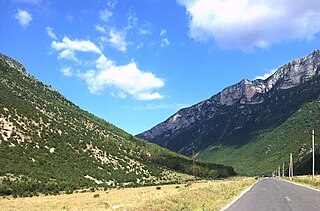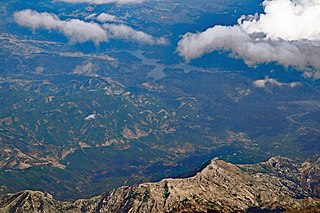Karmel Kandreva was an Arbëresh writer and poet.

Deshat is a massif situated in the Korab mountain range, on the border between Albania and North Macedonia. Positioned at the southeastern tip of the range, it is bounded by the Dibër basin to the south, Banja stream valley to the north, Black Drin valley to the west, and Radikë valley to the east.

The first siege of Krujë occurred in 1450 when an Ottoman army led by Sultan Murad II and his crown prince Mehmed II tried to besiege the Albanian town of Krujë. The League of Lezhë, led by Skanderbeg, experienced low morale after losing Svetigrad and Berat between 1448 and 1450. Nevertheless, Skanderbeg's exhortations and the support of the clergy, who claimed to have had visions of angels and victory, motivated the Albanians to defend the capital of the League, Krujë, at all costs. After leaving a protective garrison of 4,000 men under his trusted lieutenant Vrana Konti, Skanderbeg harassed the Ottoman camps around Krujë and attacked the supply caravans of Sultan Murad II's army. By September, the Ottoman camp was in disarray as morale sank and disease ran rampant. The Ottoman army acknowledged that the castle of Krujë would not fall by strength of arms, lifted the siege, and made its way to Edirne. Soon thereafter, in the winter of 1450–51, Murad died in Edirne and was succeeded by his son, Mehmed II.

Polog, also known as the Polog Valley, is located in the north-western part of North Macedonia, near the border with Kosovo.

Zajas is a village in the municipality of Kičevo, North Macedonia. Zajas was the seat of the Zajas Municipality, and is now in Kičevo Municipality.

Valamara is a massif located in eastern Albania. Converging on the borders between Korçë, Gramsh, and Pogradec municipalities, it rises at a height of 2,373 m (7,785 ft). The northern boundary is marked by Guri i Topit 2,125 m (6,972 ft) and the southern limit by Lenie.
Çuka Partizani is the highest peak of the Tomorr massif, located in south-central Albania. Part of the larger Tomorr-Kulmak-Miçan mountain range, it reaches a height of 2,416 m (7,927 ft), making it the second highest peak in the Southern Mountain Region after Maja e Papingut.

The siege of Svetigrad or Sfetigrad began on 14 May 1448 when an Ottoman army, led by Sultan Murad II, besieged the fortress of Svetigrad. After the many failed Ottoman expeditions into Albania against the League of Lezhë, a confederation of Albanian Principalities created in 1444 and headed by Skanderbeg, Murad II decided to march an army into Skanderbeg's dominions in order to capture the key Albanian fortress of Svetigrad. The fortress lay on an important route between present-day North Macedonia and Albania, and thus its occupation would give the Ottomans easy access into Albania.
Alush bey Frakulla was an Albanian leader, known for his role in the uprisings of 1835 and 1837. During the latter, he was captured together with 150 of his men and was punished with hard labor in Ottoman prisons, where he died in unknown date.

Trebeshinë is a massif situated on the border between Përmet and Tepelenë municipalities, in southern Albania.
Vito Kapo was an Albanian politician who served as Minister of the Light Industry. She was the wife of Hysni Kapo, a member of the Politburo of the Party of Labour of Albania, and a sister of the Albanian World War II hero Alqi Kondi. She was also the President of the Union of Albanian Women for nearly thirty years. Kapo was born in September 1922 in Zagori, Gjirokaster District. She died in February 2020 in Tirane at the age of 97.
Lambros Tzavelas was a leader of the Souliotes. Lambros Tzavelas was famous for his role in the Souliot struggles against Ali Pasha, the Pasha of Yanina. Tzavelas was born in Souli.
Niko Qafzezi was an agronomist and pedagogue from Albania.
The Convention of Mat was organized on 7 November 1594 by Albanian leaders fighting against the Ottoman Empire. Mat was chosen as the place of the meeting due to its role in Albanian revolts of the 16th century. The aim was a better organization of the revolts to achieve independence from the Ottoman Empire. The convention decided that help should be sought from the Pope, and for negotiations were chosen Tom Plezha, Mark Gjini and Nikollë Mekajshi. However, the Pope refused to give help, claiming that it was not the right time to fight the Ottoman Empire. Another decision of Albanian leaders was to not let the Republic of Venice know about their plans as the latter did not want to open a new conflict with the Ottomans. The news came out and Venetians managed to divide the organizers of the convention between themselves. In the following two years, Albanian leaders continued their work to get help from Christian powers, taking heart from geopolitical circumstances. In 1596, 10,000 men marched towards Vlora in hope of receiving arms from Spain but the arms sent were confiscated by Venetians. The events damaged the relations between Albanian leaders and Christian powers but did not weaken the efforts for independence.
Tom Plezha was an Albanian leader chosen at the Convention of Mat to negotiate with the Pope an alliance against the Ottoman Empire.
Mark Gjini was an Albanian leader chosen at the Convention of Mat to negotiate with the Pope an alliance against the Ottoman Empire.

Skanderbeg Mountains, also known as Vargmalet Perëndimore, are a prominent mountain range situated in the northwestern section of the Central Mountain Region of Albania. The range stretches approximately 100 km (62 mi), making it the longest in the country. It extends from the Gjadër river valley in the northwest to the Shkumbin river valley in the southeast; and from the trough of Mat in the east, to the plains between Lezhë, Tirana and Lower Shkodër in the west.
Spinarica or Spinarizza was a medieval city on the mouth of Vjosa river in southern Albania. It was an important center of trade, a status boosted by its strategic location. During its existence the city was ruled by the Byzantines, Venetians, Angevins, the Hohenstaufen dynasty and finally by the Ottomans. The exact reasons for Spinarica's decline are not known, though at the same period several important cities throughout Albania were abandoned due to socioeconomic issues caused by the Ottomans. The once prosperous city has been located by some scholars in the area of today's Zvërnec north of Vlorë.
The Battle of Përmet or Battle of Kuqarit was a battle of the Albanian Resistance of World War II against the Italian Fascists. The battle took place in 1943 near Kuqari.
Shufada was a medieval trade port in northern Albania. It was near the mouth of a river, with academics proposing Mat, Ishëm and Erzen. It was at the time one among a string of ports in Albania that enjoyed prosperity and economic significance until being abandoned at the start of the Ottoman period. An 1420 commercial treaty between Gjon Kastrioti and the Republic of Ragusa shows that Shufada was the main customs port for the former's domains.








